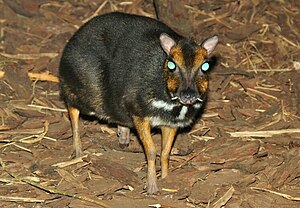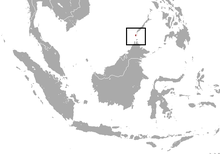Balabac-Kantschil
| Balabac-Kantschil | ||||||||||||
|---|---|---|---|---|---|---|---|---|---|---|---|---|

Balabac-Kantschil ( Tragulus nigricans ) |
||||||||||||
| Systematics | ||||||||||||
|
||||||||||||
| Scientific name | ||||||||||||
| Tragulus nigricans | ||||||||||||
| Thomas , 1892 |
The Balabac-Kantschil ( Tragulus nigricans ), also called Philippines-Kantschil , is a species of mammal from the family of the deer piglets (Tragulidae). He lives on the Philippine islands of Balabac , Ramos and Bugsuk, southwest of the island of Palawan . The animals inhabit tropical rainforests and feed on leaves, the latter being different from other deer piglets. They are also nocturnal. There is no information about the further way of life. Outwardly characteristic of the Balabac-Kantschil is the generally dark body color and three whitish stripes on the throat. It is probably closely related to the Großkantschil . The scientific introduction took place in 1892. The stock is considered to be endangered.
features
Habitus
The Balabac-Kantschil is a small representative of the deer piglets. The head-torso length is 40 to 47.5 cm, the tail length 6.5 to 8.5 cm and the shoulder height 18 cm. Weight information is not known. It is thus significantly smaller than the related greater mouse-deer ( Tragulus Napu ) to the neighboring Borneo . He is also one of the darkest members of the genus Tragulus . The back fur is dark brown interspersed with black hair, on the neck this changes to a reddish-yellow-brown color. Each individual hair is multi-colored with a light, mostly whitish to ash-gray base, a shaft of orange or brown tint and a long black tip. The belly is generally orange-brown. The groin area and the insides of the legs, on the other hand, are whitish, while the outsides of the legs are reddish-yellow-brown. A white stripe appears on the front of the hind legs from the thigh to the ankle. The white of the inside of the front legs partially extends to the chest and forms a light spot there. The tail is brown and has a white tip. The mostly dark throat is marked by three narrow white stripes, which is a hallmark of the Balabac-Kantschil. They start below the chin and extend to the chest, where they then dissolve into the dark fur. In some individuals, however, the white stripes are covered by the dark throat fur. The head is mostly darker than the rest of the body. The nose and forehead are dark brown in color, the cheeks are reddish-yellow-brown. Lighter reddish brown stripes highlight the over-eye region from the front of the eyes to the ears. A bare patch of skin surrounded by white fur appears on the underside of the lower jaw.
Skull and dentition features
The skull of the Balabac-Kantschil becomes an average of 4.4 cm wide at the zygomatic arches . The length from the base of the skull to the front edge of the palate is around 6.9 cm. The lower jaw has a length of 8.0 cm. The teeth 34 is composed of teeth with the following tooth formula : .
distribution
The Balabac-Kantschil occurs in Southeast Asia and colonizes the Philippine islands of Balabac , Ramos and Bugsuk , all southwest of the island of Palawan . The animals live in the tropical rainforests and can be found in both primary and secondary forests, as well as in large forest areas and on smaller forest islands. They use the dense undergrowth of the forests as a hiding place during the day. They may also reach mangrove areas or more open landscapes while searching for food .
A small number of animals were brought to Busunaga north of Palawan in the early 1990s , and the group grew to 21 individuals by 2006. There was also a settlement on Palawan itself, but no information is available on the current population.
Way of life
Little information is available about the Balabac-Kantschil's way of life. It is nocturnal, after which it leaves its shady resting places in search of food and goes to forest clearings. Its main diet consists of leaves , which distinguishes it from its more fruit- loving relatives. It is believed that the reproductive phase is seasonally restricted, but it is unclear whether it takes place in the rainy or dry season . Females usually give birth to one, rarely two young.
Systematics
The Balabac-Kantschil is a kind of the genus Tragulus within the family of the mouse deer (Tragulidae) and the order of the cloven-hoofed animals (Artiodactyla). The deer piglets consist of a total of three genera and are among the smallest cloven-hoofed animals. Within the group of forehead weapon bearers (Pecora) they are classified very basally, which is also genetically verifiable. The lack of forehead arms and the development of the tear duct as a single, elongated opening at the inner edge of the orbit can be seen as characteristic of the stag piglets . The genus Tragulus consists of six species, all in Southeast Asia and southern Asia are widespread and inhabit dense forests. The best-known forms are the Großkantschil ( Tragulus napu ) and the Kleinkantschil ( Tragulus kanchil ).
The first scientific description of the Balabac-Kantschil was created by Oldfield Thomas in 1892. The individual used for this was collected during Joseph Beal Steere's expedition to the Philippines in 1887 and 1888. It was a young animal in a bad state of preservation, which nevertheless showed the characteristic dark color and the light throat stripes as distinguishing features to other stag piglets. Thomas gave the island of Balabac as the type area . He considered his new species to be closely related to the Großkantschil.
In the course of the 20th century, the Balabac-Kantschil was mostly associated with the Großkantschil, among others by J. Lewis Bonhote in 1903 and Richard Lydekker in 1915. Both authors carried this under the name Tragulus javanicus . This view was confirmed when Frederick Nutter Chasen , in a series of articles on the mammalian fauna of Southeast Asia in the 1930s and 1940s, brought together all known representatives of the tragulus genus in the two best-known species, the Greater and the Small Kantschil, and the Greater Kantschil with the Java -Kantschil equated. However, Adriaan Cornelis Valentin van Bemmel contradicted this in 1949, in which he noted that the Großkantschil is not widespread in Java. The Großkantschil was then renamed again to Tragulus napu as the next available name, which is why the Balabac-Kantschil now also carried it. The Kleinkantschil was given the name Tragulus javanicus because of the priority of its name . Chasen's two-species concept for the genus Tragulus was widely accepted for the rest of the 20th century. Occasionally, however, some scientists identified the Balabac-Kantschil as an independent species, such as Colin Campbell Sanborn in 1952 .
In 2004, Erik Meijaard and Colin P. Groves presented a comprehensive study of the skulls of stag piglets based on morphometric and morphological characteristics. From their results, they concluded that the genus Tragulus contains more than two species. They therefore fanned out the Kleinkantschil and the Großkantschil more strongly and divided the newly recognized species into a Tragulus javanicus group with the smaller representatives and a Tragulus napu group with the larger members. They referred the Balabac-Kantschil to the latter. The approach of Meijaard and Groves is still valid today. It found its way into volume two of the standard work Handbook of the Mammals of the World from 2011, which mainly deals with ungulates , and was also taken into account in the new taxonomy of the ungulates presented by Groves and Peter Grubb in the same year.
No subspecies of the Balabac-Kantschil are distinguished. Sometimes one saw the Kantschile of Pulau Banggi , an island of Malaysia halfway between Borneo and Balabac, belonging to the species, as they have a similar striped pattern on the throat. However, the studies mentioned from 2004 showed clear differences to the Balabac-Kantschil and closer relationships to the Kleinkantschil. Due to the color pattern, however, the animals of Pulau Banggi are currently listed as a subspecies of the Greater Kantschils and referred to as Tragulus napu banguei .
Threat and protection
The IUCN lists the Balabac-Kantschil as " critically endangered ". This is justified with the very small distribution area on only a few islands, which possibly covers less than 5000 km². The species is also heavily hunted as a food resource; local trade as zoo animals also plays a subordinate role. The conversion of forest areas into plantations for coconut cultivation and other agricultural products also narrow the usable habitats . There are no protected areas in the distribution area of the Balabac-Kantschil. In addition to protecting local populations, settlement programs on other islands can also minimize the risk of the species becoming extinct.
literature
- Erik Meijaard: Family Tragulidae (Chevrotains). In: Don E. Wilson and Russell A. Mittermeier (Eds.): Handbook of the Mammals of World. Volume 2: Hooved Mammals. Lynx Edicions, Barcelona 2011, ISBN 978-84-96553-77-4 , pp. 320–334 (p. 333)
Individual evidence
- ^ A b Joel Asaph Allen and John Roberts White: Mammals from Palawan Island, Philippine Islands. Bulletin of the American Museum of Natural History 28, 1910, pp. 13-17
- ↑ a b c d e f g h Erik Meijaard: Family Tragulidae (Chevrotains). In: Don E. Wilson and Russell A. Mittermeier (Eds.): Handbook of the Mammals of World. Volume 2: Hooved Mammals. Lynx Edicions, Barcelona 2011, ISBN 978-84-96553-77-4 , pp. 320–334 (p. 333)
- ↑ a b c d Erik Meijaard and Colin P. Groves: A taxonomic revision of the Tragulus mouse-deer (Artiodactyla). Zoological Journal of the Linnean Society 140 (1), 2004, pp. 63-102, doi: 10.1111 / j.1096-3642.2004.00091.x
- ↑ Alexandre Hassanin, Frédéric Delsuc, Anne Ropiquet, Catrin Hammer, Bettine Jansen van Vuuren, Conrad Matthee, Manuel Ruiz-Garcia, François Catzeflis, Veronika Areskoug, Trung Thanh Nguyen and Arnaud Couloux: Pattern and timing of diversification of Cetartiodactalia, Lauriala (Mammia ), as revealed by a comprehensive analysis of mitochondrial genomes. Comptes Rendus Palevol 335, 2012, pp. 32-50
- ↑ Juan P. Zurano, Felipe M. Magalhães, Ana E. Asato, Gabriel Silva, Claudio J. Bidau, Daniel O. Mesquita and Gabriel C. Costa: Cetartiodactyla: Updating a time-calibrated molecular phylogeny. Molecular Phylogenetics and Evolution 133, 2019, pp. 256-262
- ↑ JJM Leinders and Erik Heintz: The configuration of the lacrimal orifices in Pecorans and Tragulids (Artiodactyla, Mammalia) and its significance for the distinction between Bovidae and Cervidae. Beaufortia 30 (7), 1980, pp. 155-160
- ↑ Oldfield Thomas: On some new Mammalia from the East Indian Archipelago. Annals and Magazine of Natural History 6 (9), 1892, pp. 250-254 ( [1] )
- ^ J. Lewis Bonhote: On three new races of Tragulus kanchil, Raffles, with remarks on the genus. Annals and Magazine of Natural History 7 (11), 1903, pp. 291-296 ( [2] )
- ↑ Richard Lydekker: Catalog of the ungulate mammals, Vol. IV. London, 1915, pp. 1–438 (pp. 268–280) ( [3] )
- ^ Adriaan Cornelis Valentin van Bemmel: On the meaning of the name Cervus javanicus Osbeck 1765 (Tragulidae). Treubia 20, 1949, pp. 378-380
- ^ Colin Campbell Sanborn: Mammals. Philippine Zoological Expedition. Fieldiana Zoology 33, 1952, pp. 87-158 ( [4] )
- ↑ Colin P. Groves and Peter Grubb: Ungulate Taxonomy. Johns Hopkins University Press, 2011, pp. 1–317 (pp. 56–59)
- ↑ P. Widmann: Tragulus nigricans. The IUCN Red List of Threatened Species 2015. e.T22065A61977991 ( [5] ), last accessed on August 1, 2020
Web links
- Tragulus nigricans in the endangered Red List species the IUCN 2015 Posted by: P. Widmann, 2014. Retrieved on 1 August 2020th


